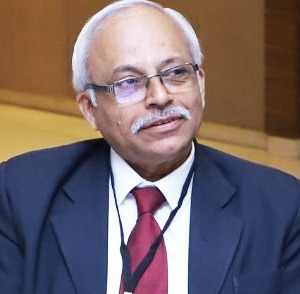COLUMN/ THE WRITE LINE

December 12, 2022: We often get to hear about a certain school of thought called Chaos Theory. It was proposed, and gets cited, by mathematicians who usually tend to lose the plot quickly when dealing with complex issues.
When asked for a definition of Chaos Theory, their usual reply is: “It is tough to define chaos, but it is easy to recognise it when you see it!” They redeem themselves by dishing out complex mathematical equations, arguing that it is a state of unpredictability in the behaviour of a complex natural system, whatever that means. Essentially, a small error can result in a much magnified disaster.
The theory has application in mathematics, engineering, economics, and biological systems such as pandemics, and many other areas that deal with uncertainty and a gaping void. The basic premise of Chaos Theory is that small differences in initial conditions, such as rounding off errors in numerical computations, can yield widely diverse outcomes for complex systems, which renders long-term predictions difficult.
Chaos Theory is one of the basic facts of humankind as most systems are non-linear, which explains why mathematical models used frequently in predicting pandemics go off the mark. It explains the paradox of systems that appear orderly and predictable but in reality have the potential to show chaotic behaviour.
Straight lines and graphs projecting into the future look orderly and predictive. Unfortunately, the spread of infections do not follow a straight trajectory. Population demographics and densities, the state of health, especially the prevalence of obesity, transmission dynamics that never remain static as a pandemic unfolds, and other nuances are missed by mouse-click modellers who predict doomsday by projecting millions of deaths worldwide.
Nevertheless, the halo effect of big scientists from big institutions along with impressive mathematical formulae and output impresses policymakers and the public, and becomes the subject of media propaganda on 24/7 TV news channels. All these together are a recipe for widespread panic and total anarchy.
The greater concern is that after events don’t unfold as these chaotic models predict, a form of circular reasoning is promoted by politicians and policymakers to rationalise the draconian measures implemented based on the defective models.
It is argued that had these measures not been implemented, there would have been a disaster on a much larger scale as predicted by the model. It’s a win-win situation for modellers and policymakers. And modellers rush to the drawing board to make the next model, which has the potential to create further chaos and anarchy.
Studying the trends at the ground level in India from the beginning, without the assumption that one size fits all, could have provided the world scientific community a crucible to understand the Covid-19 pandemic. India is the most geographically and socially diverse country in the world. Inhabitants include the world’s richest as well as the poorest. Between these two extremes, all socioeconomic gradients are included, from privileges to deprivations. Housing ranges from mansions to slums where a room may be shared by 8-10 people without any ventilation.
The global impact of the predictions from Imperial College London was disruptive and disastrous, particularly in a hugely populated country like India with its pre-existing socioeconomic disparities. It also resulted in different transmission dynamics determined by socioeconomic stratum. While the term ‘social distancing’ was frowned upon as being politically incorrect, it is a stark reality in Indian society.
The gap between the haves and have-nots in Indian society widened further due to the socially insensitive, harsh and restrictive measures. The privileged worked from home while the poor were driven back, many on foot, to their native villages hundreds of miles away, or pushed into their crowded living quarters in slums and tenements.
They lost livelihoods, and in their crowded homes encountered intense transmission during the first wave of the pandemic, while the so-called ‘baba logs’ in their more comfortable homes, comprising over 70% of the Indian population, religiously followed what was called ‘Covid-appropriate behaviour’, waiting for the vaccine to roll out before stepping out of their comfortable homes!
The first wave in our country encountered the following speed-breakers. Those at the lower end of the social gradient living in crowded conditions acquired natural immunity very quickly from encountering the coronavirus. The majority of them survived the infection without much fuss.
Subsequent seroprevalence studies established that the infection fatality rate was below 0.1 % in India. Those at the higher end of the social stratum avoided infection due to Covid-appropriate behaviour. However, this stratum, the bulk of this Indian population remained susceptible.
The first wave ended around the beginning of 2021. The nation was lulled into complacency thinking the worst was over. Soon, vaccine were rolled out in the first quarter of 2021, and the baba log lined up, some getting vaccinated and then stepping out of their homes.
It was like feeding dry wood to fire. The largely susceptible middle-class drove the second wave of the pandemic in the country. The panic level hit the sky as it was fuelled by an information overload due to 24/7 news channels, which indulged in propaganda and sensation to drive TRPs. It led to a sort of medical stampede during the second wave. Overwhelming numbers caused the chaos and anarchy, not the lethality of the virus itself.
The Indian experience sums up the dynamics of this pandemic. Covid-appropriate behaviour and draconian measures can’t prevent the run of the virus through communities – they only postpone the inevitable. These measures leave the population susceptible to infection in the future. Depending only on vaccination as the way out of the pandemic is naive.
The present paradox of Taiwan and Australia, countries that controlled Covid-19 very well in the beginning, facing surges both in Covid-19 cases and deaths even after the roll-out of mass vaccination (as shown in the graphs) should not surprise us if we study the Indian experience.
THE AUSTRALIA PARADOX

THE TAIWAN PARADOX

Similar phenomenon after mass vaccination has been observed in many countries.
One would have thought that such real-world hard data would drive mid-stream course correction. Obviously, the impact of indiscriminate mass vaccination of the young and old, the healthy young and the vulnerable is minimal at the population level, if at all. Rather, the trends show an increase in cases and deaths.
But authoritative voices that dictate public health policy appear to defend the vaccines at all costs, turning a Nelson’s eye to real-world hard data that even a high school student can easily understand. Even an illiterate person can easily make out there’s an asymmetrical rise in cases and deaths from the graphs before and after vaccination.
There is a saying that a learned blockhead is a bigger blockhead than an illiterate one. Proving this point is a paper by learned researchers in the Lancet, which estimates that at the global level, vaccines have prevented almost 20 million deaths from Covid-19, and in India, about 4 million deaths. This estimate is based on mathematical models and funded by the World Health Organisation (WHO), GAVI Vaccine Alliance, Bill and Melinda Gates Foundation, among other stakeholders. Elementary, my dear Watson!
Here’s a million-dollar question: How do they explain the lowest rates in most African countries that also have the lowest rates of vaccination? Perhaps they will go back to the drawing board to make another mathematical model!
(Dr. Amitav Banerjee, MD, is a clinical epidemiologist, professor, and Head of Community Medicine at Dr. DY Patil Medical College, Pune. He has over two decades of experience in the Indian Armed Forces as a field epidemiologist. He led the Mobile Epidemic Investigation Team at the Armed Forces Medical College Pune from 2000-2004, when he investigated many outbreaks. He was awarded for his work on Tribal Malaria and its impact on soldiers serving in hostile terrain.)
REPUBLISHING TERMS:
The above content reflects the opinions of the author, and not necessarily those of Empire Diaries. All rights to this content are reserved. If you want to republish this content in any form, in part or in full, please contact us at writetoempirediaries@gmail.com.













Reblogged this on Calculus of Decay .